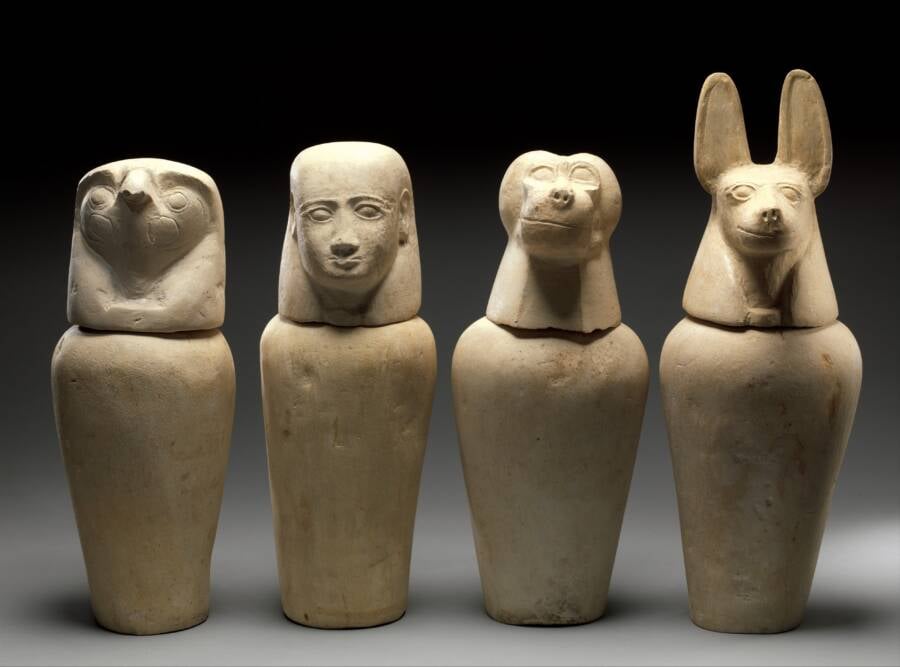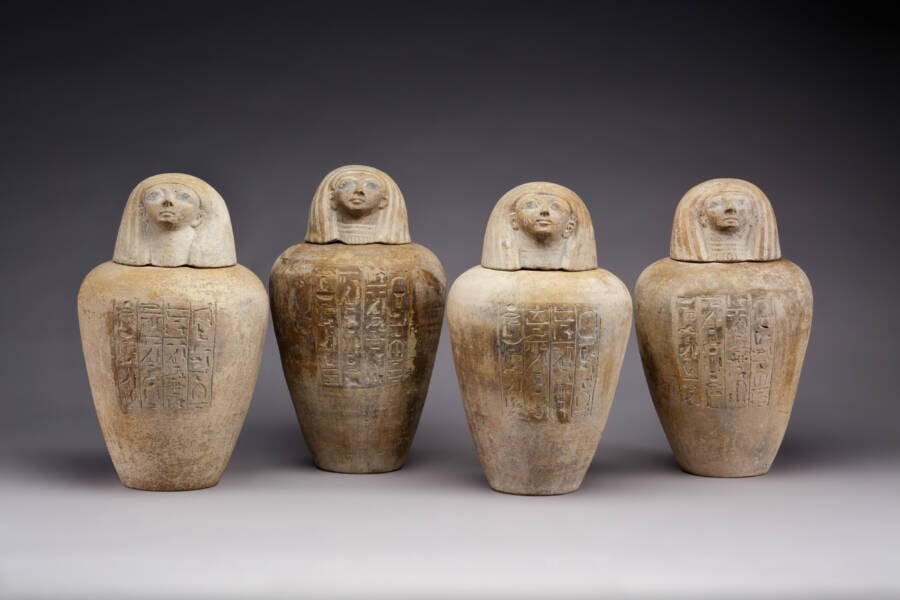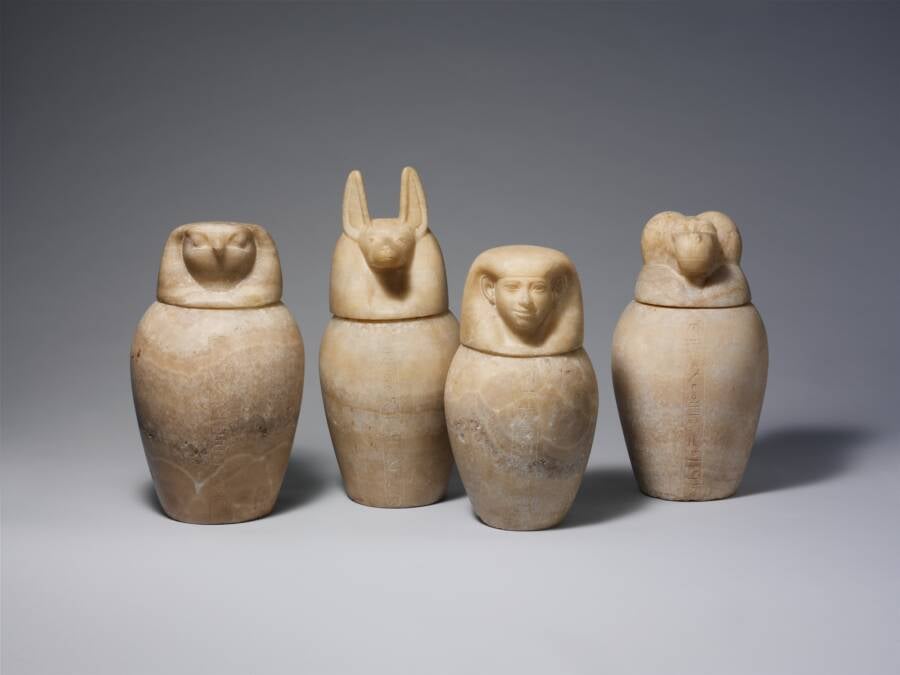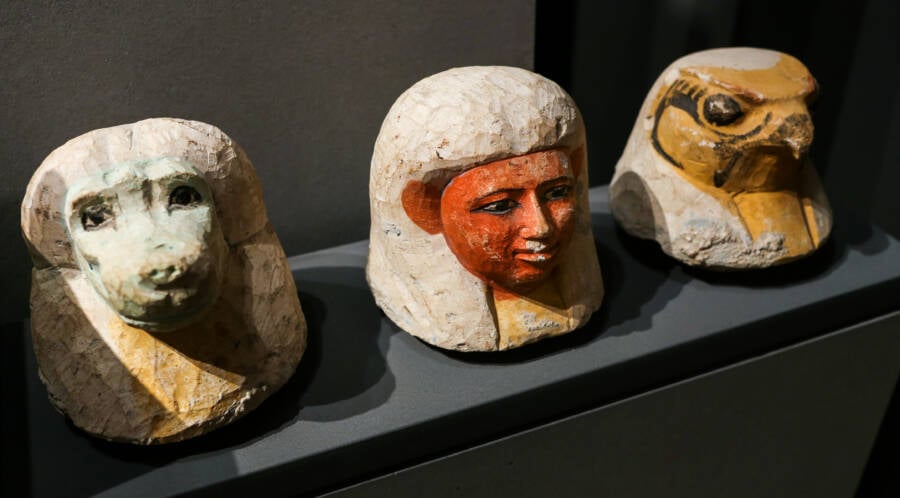Canopic jars helped preserve certain organs that were removed during the mummification process — and they were often stored in the same tomb as the actual mummy.

Wikimedia CommonsIn ancient Egypt, canopic jars were used to store some of the organs of the deceased.
Mummification is one of the most well known ancient burial practices — most commonly tied to ancient Egypt. The practice of preserving and ritually treating a body in preparation for the afterlife serves as a fascinating glimpse into the customs of the ancient Egyptians, allowing modern researchers to unpack that culture and share their findings.
But mummification involved more than just wrapping a body in bandages, especially for royal and elite citizens. It was a multi-step process that involved cleansing the body, removing numerous organs, treating the remains with salt, embalming the body with resins and oils, and wrapping the body. Many organs removed from the body were not simply discarded either — they were placed in funerary vessels known as canopic jars.
These jars were infused with religious meaning, artistic craftsmanship, and deep care for the person’s journey into the afterlife. Their evolution over the various periods of Egypt’s history also creates a fascinating timeline, showing how the larger culture changed amidst different religious and artistic practices as time went on.
Though not quite as famous as the mummies they accompanied in the tombs, canopic jars are just as captivating.
The Ritual Purpose Of Canopic Jars

Wikimedia CommonsThese canopic jars were meant to represent the Four Sons of Horus.
Canopic jars had several key purposes in Egyptian funerary practices.
The first was the preservation of the viscera. Canopic jars safeguarded some key internal organs — the lungs, liver, stomach, and intestines — that were removed during mummification to halt decay of the corpse. After their removal, the organs were dried with salt and anointed with oils, so they’d last as long as possible once they were placed inside the canopic jars.
But the function of these jars went beyond simple physical preservation: They were also seen as a vital component for the deceased’s spiritual journey to the afterlife. It was thought that the intestines, liver, lungs, and stomach were necessary for the person to move on to the next world — as these organs were believed to be made up of different “entities” that lived on even after the person died, along with other parts of the deceased’s body.
Storing them in sealed vessels ensured that the person remained “whole” in the afterlife, so it was crucial that these body parts were well-preserved, and they were often placed in the same tomb as the actual mummy.
(It’s worth noting that not all of the organs were stored in canopic jars. Egyptians believed that the person’s heart needed to remain inside their body, and interestingly enough, they usually disposed of the person’s brain entirely because they didn’t believe it was important enough to preserve.)
Many canopic jars were decorated with the sculpted heads of animals, people, and divine figures. One especially common set of canopic jars represented the Four Sons of Horus. Horus was an Egyptian god linked to both power and healing, and his four sons were each believed to protect a particular organ, each with the help of a different goddess.
A jar bearing the depiction of Imsety, represented by a human head, was used to guard the deceased’s liver and was believed to be guarded by Isis. The lungs were stored in a jar designed to look like a baboon, representing Hapi (or Hapy), and protected by the goddess Nephthys. The stomach was placed in the jackal-headed jar of Duamutef, under the watch of the goddess Neith. And the intestines were placed in the jar of Qebehsenuef, the falcon-headed figure, under the guard of the goddess Serket.
The presence of the Four Sons of Horus was only common during the New Kingdom period, though. They were meant to invoke the deities’ protective powers, but earlier canopic jars were far plainer, which shows how this religious practice evolved over time and took on a deeper spiritual meaning.
How Canopic Jars Evolved Throughout Ancient Egypt’s Historic Kingdoms

Wikimedia CommonsHuman head-shaped lids were common for canopic jars during Egypt’s Middle Kingdom time period (though these pictured jars are believed to be from the New Kingdom).
The earliest canopic jars, dating back to Egypt’s Old Kingdom (circa 2686–2181 B.C.E.), were fairly simple in design. They were carved from stone, without any real defining features or inscriptions. The Old Kingdom canopic jars were, well, just jars — or jar-shaped vessels in the most obvious sense — that were just big enough to hold their specified organs.
Toward the end of the Old Kingdom, some of the jars were made out of nicer pottery materials and featured some basic patterns, but the more important development was just how widespread they became.
Then, by the Middle Kingdom (circa 2025–1795 B.C.E.), the lids started to feature designs in the shape of human heads. It’s possible that the earlier, more rudimentary versions of canopic jars also had some deeper spiritual meaning, but the human-headed jars provided more definitive evidence of the vessels’ spiritual importance, especially since some of them were already starting to resemble the Sons of Horus, and some of them even represented more idealized versions of the deceased person. And this style stuck around for a while too, pretty much up until the New Kingdom period.

Wikimedia CommonsA limestone, human-headed canopic jar.
The New Kingdom (circa 1550–1069 B.C.E.) saw the last major change in the style of canopic jars, shifting to the more iconic representations of the Four Sons of Horus as their animal-headed versions (and human-headed, in Imsety’s case). During this time, artisans put more emphasis on the decorative aspects, as many jars featured intricate designs and were made from higher-quality materials like alabaster, aragonite, or glazed porcelain.
Some were also decorated with protective spells, which were inscribed on the jars with the intention of helping with the preservation of the deceased’s body parts and assisting the person in their journey to the afterlife.
Eventually, though, the jars’ practical uses began to wane. By the Third Intermediate Period (circa 1069–664 B.C.E.), the embalming process had advanced to the point where organs were often returned to the body. And yet, dummy canopic jars continued to appear in tombs, indicating that their symbolic importance remained unshaken even when they didn’t hold organs.
Modern Research On These Ancient Vessels

Wikimedia CommonsThough canopic jars may seem strange to us today, they’re part of the reason why ancient Egyptians had such expansive knowledge of human anatomy — and why Egyptians were so advanced when it came to surgeries.
Given how widespread and unique canopic jars are, it’s natural that scientists and other experts have studied them closely as a specific point of historical interest. Numerous studies and analyses have been conducted on canopic jars, each providing new insights into their ancient purposes.
One of the most notable studies emerged in 2022. For the study, researchers applied ancient DNA techniques on 140 canopic jars to extract DNA, marking the first time that isolated DNA was pulled from the vessels. The experts were also able to present ancient DNA degradation patterns and shotgun‐sequenced metagenomic profiles of the contents inside the jars.
Although the contents were fragmented and low-quality (possibly due to the embalming treatments), the work also revealed the complex bacterial composition of the materials, offering a glimpse into ancient microbiomes — though no clear pathogens were able to be identified.
A few years earlier, in 2018, another study examined canopic jar samples and mummy samples to take a closer look at the embalming fluids used to preserve body parts. Using a new untargeted metabolomics-like screening approach, they detected materials like beeswax, coniferous resin, and aniseed constituents, providing more insight into ancient embalming recipes.

Wikimedia CommonsThe painted lids of canopic jars on display.
More research into the components used during mummification was carried out in early 2025, when researchers performed the first systematic odor and chemical analysis of multiple Egyptian mummies from different time periods. They effectively figured out the “scent of eternity,” identifying woody, spicy, and herbal notes in the materials used during the funerary rituals.
In each of these instances — and through other studies — researchers have steadily gained new knowledge about the funerary practices of the ancient Egyptians. The results have further showed that the mummification process was a multi-layered and spiritual one, thanks to deeply entrenched beliefs in a promised afterlife and a passage to the next world.
The presence of empty canopic jars in later periods is only further proof of this ritual significance. These vessels not only preserved organs but also served as key spiritual objects, providing a sense of divine watchfulness as people prepared to send their deceased on to the next life.
After learning about canopic jars, read about the khopesh sword, and how it helped shape ancient Egypt. Then, go inside the eerie history of bog bodies.





